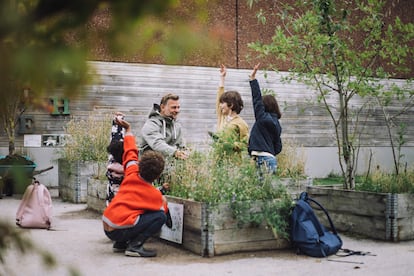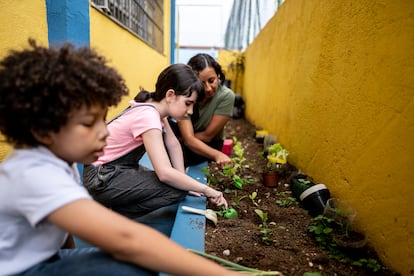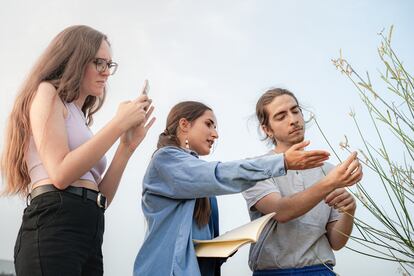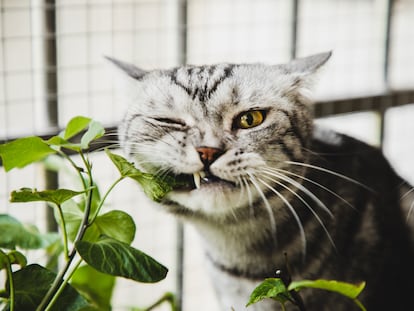Plants in class and classrooms in the garden: when nature becomes the best textbook
Teachers are crying out for greener playgrounds and outdoor spaces where pupils can connect with the learning potential of the plant world. More plants and less cement is the right formula for friendly and sustainable schools

Every morning, around 11:50, the bell rings in elementary, middle, and high schools for thousands of children and young people to go out for recess. It will be like this every day from Monday to Friday until late June. But maybe the school playground is not everything it could be. Yves Raibaud, a researcher, teacher, and specialist in inclusive urban planning, has studied schoolyards in depth. He has analyzed how traditional, asphalt-covered playgrounds encourage hierarchical games, with elite groups occupying the central space and the others relegated to the periphery. “We must change the design and dynamics of the schoolyard and put an end to the current rigid concept that allows these concrete spaces to be surrendered to exclusive and exclusionary games. We must bring nature into playgrounds,” says César del Arco, a high school biology teacher.
Del Arco has participated in various projects to create open classrooms in schools in Castilla y León (Spain). Nature is key. “Having a school garden is very important, but we must go further and allow nature to permeate the entire school environment.” This involves not only growing flowers and vegetables, but also creating outdoor classrooms that can be used to teach any subject, thus promoting interdisciplinary learning. Plants are a great support for project-based learning and challenges. This has been demonstrated by the initiatives in which Del Arco has participated. “The aim of the school garden is to generate questions that get the students involved in finding the answers as if they were researchers,” he explains.
“The list of plants that can be put to an educational use is endless,” Del Arco continues. Saffron has a wealth of teaching potential because it allows us to talk about ethnobotany, history, radial geometry, and even economics. “An exercise might be to invite students to think about why the value of saffron is so high, by weighing the pistils of the fresh and dried flowers.” And there are many other options. In February, daffodils can support genetics and geometry lessons or be used to teach fractals. In mathematics, plants such as corn, sunflowers, and mushrooms are very interesting because of their rapid growth, which is noticeable from one day to the next. “You can stick a ruler next to them and do observation activities to make graphs of their growth,” the teacher suggests. The spirals of conifer cones or the tendrils of a Boston ivy that covers a playground wall illustrate Fibonacci’s mathematical sequence and the proportions of the golden ratio. Maples, birches, and ash trees allow us to design experiments in physics: simply throwing the seed pods into the air and calculating how long it takes them to fall will make aerodynamic formulas clearer. In music class, the potential of plants is inexhaustible. Flutes can be made from bamboo canes; peas or any other plant that has seed pods can be incorporated into maracas; and so on… The possibilities are practically endless in art class too, with projects such as experimenting with collage, practicing the transfer of textures with charcoal, working on braiding with natural fibers, making pigments from flowers and roots, or making insect hotels with pine cones, horsetail sticks, bamboo canes, old tiles and bricks, pallets, or other recycled material.

“The flowers of the nightshade (Mirabilis jalapa) are perfect for clarifying questions about the mechanisms of dominant and recessive genes in high school genetics classes,” says Del Arco. In physical education, the garden’s harvest is key to talking about nutrition. You can design exercise tables with routines associated with work in the garden (squats, strides, etc.) and practice yoga and breathing exercises with aromatics such as rosemary, lavender, mint, or thyme. These aromatics are also interesting for contextualizing topics in history and for doing experiments in chemistry, such as a soap-making workshop. Furthermore, they are the ideal species to create sensory pathways in which students can experiment with textures and aromas. “[This is] something that is highly recommended for working with children and young people with special needs, including ADHD,” says the teacher. “The simple fact of being outdoors makes the student more motivated and receptive,” he says.
The flourishing of humanities education
In education on the humanities, the scientific nomenclature of plants connects us with subjects from the branches of modern and Classical languages. “We will learn that sativus (as in Cucumis sativus, cucumber) means cultivated. Officinalis (as in Lavandula officinalis, lavender) means medicinal. And vulgaris (as in Thymus vulgaris, thyme) means common,” the teacher says. They will recognize the acanthus leaves on the Corinthian capitals in art history class without having to memorize it. In our own language classes, the names of garden tools and tasks lead us to literary words, archaisms, or disused words. And you can learn the vocabulary of the orchard and the garden in all the languages taught at each institution.
Counting the rings on a tree stump allows you to establish dates that can be related to historical events and then make a timeline. And who has not germinated seeds on moistened cotton? “One more step is to draw the process in vignettes to create a comic. Or ask students to take a couple of photos a day and then edit them with a video editing program to make their own stop-motion short. Corn, watercress, mustard, or any legume seeds are perfect for this experiment,” suggests the biology teacher.
Shade, coolness, places to sit, and other tips for a school garden
The guidelines for designing a good school garden are to keep in mind the local hardiness index (which is given by the minimum temperatures throughout the year in the place where the school is located), choose plants that require little irrigation, prioritize native species, and avoid toxic or thorny plants such as oleanders, cotoneaster or crataegus. Del Arco indicates four environments that should not be forgotten: “A grove with deciduous species, to benefit from the light in winter and the shade when the heat of summer begins; an orchard; an aromatic area; and flowerbeds or planters of perennials with flowering periods that are staggered for pedagogical use: garlic, onions, lilies, crocuses, tulips, lupines, hostas, etc. Furnishing the patio with tree stumps that serve as tables and seats is a good idea to come full circle.

In addition to being ideal teaching environments, open classrooms contribute to creating more sustainable cities, which connects with the 2030 Agenda. “These spaces function as green islands, they are hotbeds of biodiversity and bring nature closer to schools,” argues Del Arco. The ideal scenario is for the students and the whole community to participate in the design, “forming groups with parents and neighbors to tend to the plants during the holidays,” he adds. “It can be a very enriching intergenerational experience for young people to learn about gardening, ethnobotany, and traditional crafts from their grandparents.” Schools can go the extra mile by incorporating elements such as green roofs that help regulate the temperature inside the building (in the summer as well as the winter), rainwater collection systems for irrigation, compost bins, and raised planters so that all students can work in them. Likewise, by bringing plants inside the school so that, in addition to decorating, they create a teaching and learning route that connects with the playground.
Furthermore, nature provides the perfect excuse to address education in values and activities that encourage debate and reflection. “Each academic year I suggest my students read The man who planted trees, by Jean Giono,” says Carlos López, a teacher of art history and secondary school tutor. “It is a frank and moving story that touches on topics such as environmentalism, philanthropy, altruism, the value of perseverance, humility, and many more.” It is a delightful story that highlights the need to take care of our immediate environment in which we coexist with other people, animals, and plants. It is a lesson that is best learned when we are young, and where better than in the school yard?
Sign up for our weekly newsletter to get more English-language news coverage from EL PAÍS USA Edition
Tu suscripción se está usando en otro dispositivo
¿Quieres añadir otro usuario a tu suscripción?
Si continúas leyendo en este dispositivo, no se podrá leer en el otro.
FlechaTu suscripción se está usando en otro dispositivo y solo puedes acceder a EL PAÍS desde un dispositivo a la vez.
Si quieres compartir tu cuenta, cambia tu suscripción a la modalidad Premium, así podrás añadir otro usuario. Cada uno accederá con su propia cuenta de email, lo que os permitirá personalizar vuestra experiencia en EL PAÍS.
¿Tienes una suscripción de empresa? Accede aquí para contratar más cuentas.
En el caso de no saber quién está usando tu cuenta, te recomendamos cambiar tu contraseña aquí.
Si decides continuar compartiendo tu cuenta, este mensaje se mostrará en tu dispositivo y en el de la otra persona que está usando tu cuenta de forma indefinida, afectando a tu experiencia de lectura. Puedes consultar aquí los términos y condiciones de la suscripción digital.
More information

Natural pest control: Plants enlist their enemies’ enemies
Últimas noticias
The metaverse, four years later: Is it finished or just at a standstill?
$3,000 and a plane ticket: The United States increases incentives for migrants to self-deport before the end of the year
Charles Dubouloz, mountaineering star, retires at 36 with a farewell tour inspired by Walter Bonatti
From the White House to diplomatic gifts: Lego wins over adult fans, brick by brick
Most viewed
- The low-cost creative revolution: How technology is making art accessible to everyone
- Families demand repatriation of bodies of Colombians who died in Ukraine: ‘This war is a slaughterhouse for foreigners’
- Christian Louboutin: ‘Young people don’t want to be like their parents. And if their parents wear sneakers, they’re going to look for something else’
- All the effects of gentrification in one corner of Mexico’s Colonia Roma
- Christmas loses its festive spirit: ICE fears cast shadow over religious celebrations









































